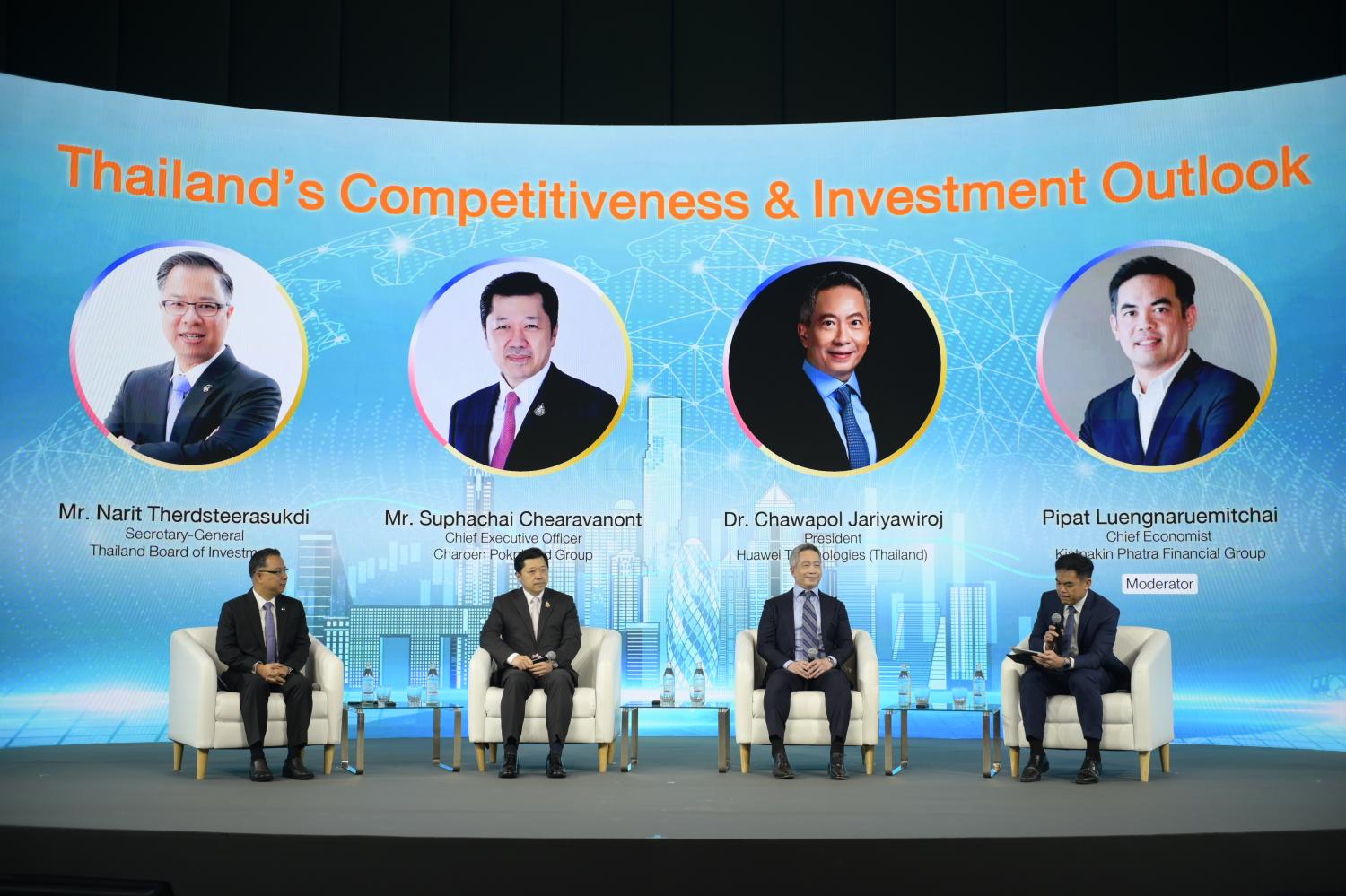Thailand Focus 2025 highlighted a clear, data-backed vision: Thailand should attract more talent and harness advanced technology to sharpen its competitive edge amid shifting global dynamics. The forum, convened by the Stock Exchange of Thailand, brought together three prominent voices to discuss competitiveness and investment, underscoring the importance of stronger global connectivity and a platform that unites regional trade with digital innovation. The organizers framed the discourse around resilience, sustainable growth, and the strategic role of technology in shaping Thailand’s future economy. The speakers emphasized that the nation’s appeal lies not only in its current infrastructure but also in its ability to attract talent, foster innovation, and integrate new industries into a coherent national strategy. The session, marked by thoughtful analysis and forward-looking proposals, painted a comprehensive picture of how Thailand can leverage its strengths to stay competitive in an era of rapid technological change and global disruption.
Investment momentum and market access
Thailand’s investment story over the last decade has been characterized by steady expansion and a notable acceleration in recent years. The secretary-general of the Board of Investment reported a remarkable surge in investment applications during 2024, with figures surpassing the 1-trillion-baht threshold and marking a 35 percent rise from 2023. Foreign direct investment also climbed, recording a 25 percent year-on-year increase. This upward trajectory extended into the first half of 2025, when investment applications exceeded US$32 billion, representing a remarkable 139 percent year-on-year growth. These numbers were framed by the speakers as evidence of persistent confidence from global investors in Thailand’s growth prospects, even amid broader global uncertainties. The data also highlighted the country’s diversified investment base, with the top five FDI sources identified as Singapore, China, Hong Kong, Taiwan, and Japan, underscoring Thailand’s regional attractiveness and its role as a bridge between major Asian economies.
Beyond the headline figures, the discussion delved into the structural advantages that underpin this investment momentum. Thailand’s economy benefits from a resilient and cost-effective business environment, reinforced by world-class infrastructure that includes deep-sea ports and international airports, complemented by more than 70 industrial estates nationwide. The digital backbone was described as equally robust, featuring top-tier data centers that underpin the country’s growing digital economy and data-driven industries. The government’s market-access framework is a critical enabler of long-term investment, with 17 free trade agreements spanning 24 countries, creating significant opportunities for manufacturers and service providers to scale across regional markets.
The forum also highlighted Thailand’s strategic position within global supply chains thanks to its status as a member of the Regional Comprehensive Economic Partnership (RCEP), recognized as the world’s largest trading bloc. This membership reinforces Thailand’s role in automotive, electronics, and chemicals supply chains while providing a stable platform for adjacent industries such as electric vehicles (EVs), semiconductors, and advanced electronics to emerge and scale. The emphasis on these sectors reflects a deliberate strategy to anchor new growth areas to established industrial strengths, leveraging existing capabilities to accelerate the development of high-value downstream activities.
In terms of sustainability and energy, the speakers highlighted green-energy initiatives as a key differentiator for investors seeking long-term reliability. A mechanism known as the Utility Green Tariff enables businesses to purchase clean energy bundled with renewable energy certificates, aligning electricity supply with sustainability objectives. Additionally, plans to offer direct power purchase agreements (PPAs) were discussed, with the government allocating 2,000 megawatts of renewable power specifically for data center operations. This kind of targeted energy policy signals a deliberate effort to create predictable cost structures for energy-intensive facilities, reinforcing Thailand’s attractiveness for data-centric industries.
The participants stressed that Thailand’s competitive advantages must address both short-term dynamics and longer-term structural shifts. The trade and technology landscape is framed as a long-duration game, requiring ongoing emphasis on sustainability, resilience, and the ability to adapt to evolving geopolitical conditions. In parallel, Thailand is actively engaging with the United States to secure favorable terms on transshipment tariffs, reflecting a proactive approach to shaping a favorable policy environment for investors. The overarching message is that a smart, sustainable, and well-coordinated industry strategy is essential to strengthen Thailand’s standing in global markets, particularly for existing investors who are considering upgrading their production facilities through automation, digitalization, and the integration of artificial intelligence.
Underpinning these strategic aims are targeted government measures aimed at localization. The government is pursuing localization incentives for manufacturers of EVs and electrical appliances, with the explicit goal of achieving higher local content percentages. This approach is designed to improve domestic value addition, support domestic firms, and ensure that investment translates into durable capability within Thailand’s economy. The country’s talent pool—an estimated 100,000 graduates annually in science, technology, engineering, and mathematics—provides a ready pipeline to support these advanced manufacturing and technological upgrade efforts. The combination of robust demand drivers, a diversified investment base, and a clear emphasis on sustainable, future-ready assets positions Thailand to maintain momentum in the face of global uncertainty and competitive pressures.
Key takeaways from this section include:
- A sustained, multi-year investment upswing driven by confidence from global investors and diversified sources of FDI.
- A strategic focus on high-value sectors (EVs, semiconductors, advanced electronics) linked to established industrial bases.
- A strong, expanding digital infrastructure complemented by favorable energy policies and green tariffs to support data-intensive activities.
- Active pursuit of new FTAs with major partners to broaden market access and reduce trade frictions.
- Local content incentives and a large STEM talent pool to facilitate automation, digitalization, and R&D investments.
Infrastructure, digital backbone, and sustainability
Thailand’s infrastructure is repeatedly framed as a core competitive advantage that complements its growing digital economy. The forum participants described the nation as having a robust physical infrastructure backbone—deep-sea ports, international airports, and an extensive network of industrial estates—that can accommodate rising demand from manufacturers, logistics operators, and technology providers. Complementing this is a digital infrastructure layer characterized by world-class data centers and a growing ecosystem for data-driven services. This dual strength—physical and digital—provides the foundation for a range of strategic initiatives designed to attract investment, reduce operating costs, and accelerate the adoption of advanced technologies across sectors.
One notable element of the digital agenda is the emphasis on data-centric capabilities and sovereignty-enhancing solutions. The discussion highlighted the importance of secure, scalable data infrastructure to support the AI economy and the broader digital transformation underway in Thailand. This includes the concept of sovereign data centers and data platforms designed to operate within a trusted national framework, aligning with global best practices for data privacy, security, and reliability. A recurring theme is the need to ensure that data flows, analytics, and digital services can be accessed reliably by both public and private sectors without compromising security or national strategic interests.
Sustainability features prominently in the infrastructure narrative. The Utilities Green Tariff is presented as a practical mechanism to promote green energy adoption by businesses. By bundling clean power with renewable energy certificates, companies can demonstrate their commitment to sustainability and potentially realize favorable economic terms. The plan to offer direct PPAs for data centers underscores a deliberate strategy to align energy consumption with predictable, competitively priced renewable power. This is particularly relevant for data-intensive operations that require stable energy access and cost control over the long term. The government’s initial allocation of 2,000 megawatts of renewable energy for data-center users signals a prioritization of the digital economy within the country’s energy portfolio.
Beyond energy and physical infrastructure, the forum emphasized the importance of improving global connectivity as a means to secure a larger role within regional and global supply chains. Enhanced logistics, streamlined regulatory processes, and improved cross-border cooperation were highlighted as essential components of a modern, integrated ecosystem. The aim is to create a seamless environment in which international firms can move goods, data, and services with minimal friction, thereby reinforcing Thailand’s position as a hub for regional trade and digital innovation.
In practical terms, this infrastructure narrative translates into several actionable policy directions. It includes continuing investments in port capacity, road and rail links to reduce transit times, and upgrades to airports to support growing passenger and cargo demand. On the digital side, it involves expanding data-center capacity, ensuring robust cybersecurity, and promoting interoperability among different data platforms to enable secure data sharing and AI-driven decision-making. The overarching objective is to craft an environment where high-tech manufacturers, service providers, and digital platforms can operate at scale, benefiting from lower costs, greater resilience, and faster time-to-market.
Key takeaways from this section include:
- A reinforced physical and digital infrastructure backbone capable of supporting high-value manufacturing and digital services.
- Strategic use of sovereign data infrastructure and data platforms to reinforce national security and data governance.
- Energy policy alignment with sustainability goals, including green tariffs and renewable PPAs tailored for data centers.
- Greater emphasis on global connectivity to strengthen Thailand’s position in regional supply chains and digital trade.
Focus on green energy integration and resilience
The forum connected energy policy to manufacturing resilience and digital competitiveness. The green-energy initiatives are framed as not only environmental benefits but also enablers of economic resilience. A line of reasoning presented is that predictable energy pricing, anchored in renewable power and supported by renewable certificates, reduces operational risk for energy-intensive industries and data-centered operations. This is particularly critical for investors evaluating a long-term investment horizon where energy costs and reliability directly impact total cost of ownership and return on investment calculations. The ability to secure stable, renewable power through PPAs further reduces exposure to fossil-fuel price volatility and helps attract energy-intensive players, such as data centers and advanced manufacturing facilities, who require dependable, long-term energy arrangements.
As Thailand positions itself as a platform for regional innovation, the energy framework is integrated with the country’s broader digital and industrial strategy. The commitment to allocate renewable capacity for strategic sectors signals a coordinated policy approach that aligns energy, infrastructure, and technology to reduce bottlenecks and improve overall competitiveness. This synergy is expected to yield benefits in reduced time-to-market for new products, improved reliability for critical digital services, and stronger environmental, social, and governance (ESG) credentials for Thai-based enterprises.
Global trade positioning, energy policy, and policy coherence
Thailand’s strategic positioning in global trade and policy coherence emerged as a central theme in the forum. The nation’s participation in multiple FTAs and its status as a member of RCEP create a framework for sustained access to key markets and suppliers, enabling Thai businesses to participate effectively in regional and global value chains. The discussion highlighted 17 FTAs spanning 24 countries as a core strength that supports market diversification and risk management for manufacturers and exporters. Importantly, the government’s ongoing negotiations with the European Union and Canada signal an intent to broaden this network further, potentially unlocking new corridors for trade, technology transfer, and investment.
The forum stressed that a long-term approach to trade policy must remain sensitive to evolving global conditions. The dynamic nature of trade tensions and tariff policies requires a proactive stance to safeguard competitiveness. In this context, Thailand’s dialogue with the United States on transshipment tariffs was framed as a pragmatic effort to secure favorable terms for investors, particularly those involved in logistics and trade operations. The objective is to preserve Thailand’s attractiveness in a global environment where tariff regimes can shift rapidly, impacting supply chains, input costs, and ultimately the price competitiveness of Thai goods on the world stage.
From a sectoral perspective, the policy environment is seen as a key enabler of industrial upgrading and diversification. The emphasis on foundational sectors—automotive, electronics, and chemicals—serves as a stable base for breakthroughs in related, higher-value activities such as EVs, semiconductors, and advanced electronics. The policy approach is not limited to traditional manufacturing; it also aims to stimulate growth in new value-added activities by leveraging the country’s capacity for innovation, its favorable business climate, and its integrated regional position. Achieving this requires continuous alignment of regulatory frameworks, investment incentives, and talent development programs with market opportunities and emerging technologies.
Subsections beneath this theme emphasize:
- The strategic advantages of RCEP membership for supply chain resilience and market access.
- The importance of ongoing FTAs with major economic partners to expand competitive thresholds.
- The need to manage tariff exposure through proactive dialogue and policy adjustments.
- The role of policy coherence in transforming existing manufacturing assets into advanced, value-added operations.
Smart industry strategy, localization, and future readiness
A core strand of the forum’s guidance centers on smart, sustainable industry development and the optimization of existing investments. The government is urged to pursue a comprehensive policy framework that supports upgrading production facilities with automation, digital technologies, and artificial intelligence. This approach aims to improve productivity, quality, and throughput while reducing lifecycle costs and environmental impact. The rationale is that by modernizing current factories, Thailand can strengthen its competitive position without necessarily abandoning its established manufacturing base.
Localization measures for EVs and electrical appliances reflect a deliberate attempt to balance openness with domestic capability building. By incentivizing local content production, the state seeks to ensure that a meaningful share of value addition remains in Thailand, enhancing supply chain resilience and fostering domestic industrial ecosystems. These steps are expected to generate spillover benefits across supplier networks, training pipelines, and local innovation activities, contributing to a more robust national economy.
In discussing human capital and workforce needs, the forum highlighted a robust talent pipeline, projecting roughly 100,000 graduates annually in science, technology, engineering, and mathematics. This flow of skilled graduates is a critical input for automation, digitalization, and AI adoption across sectors. The emphasis on a skilled workforce aligns with the country’s broader strategy to attract foreign talent while ensuring that local graduates are well-positioned to participate in high-value activities. The debate touched on nurturing capabilities in software development, data analytics, cybersecurity, and hardware design—areas essential to sustaining a tech-enabled industrial base.
Strategic implications for policymakers and industry participants include:
- Accelerating automation and digitalization across traditional factories to maintain cost competitiveness.
- Expanding incentives that encourage private-sector investment in R&D, upskilling, and advanced manufacturing capabilities.
- Designing a localization framework that links local content requirements with support mechanisms for domestic suppliers and SMEs.
- Ensuring that talent development aligns with industry needs, including alignment between curricula, employer demand, and research opportunities.
- Building a supportive ecosystem for emerging technologies such as AI, robotics, sensors, and automated manufacturing systems.
The long-term objective is to cultivate a sustainable, diversified industrial base that can compete on a global stage while being adaptive to market shifts. The emphasis on smart industry strategies signals a recognition that the most enduring competitive advantage comes from the seamless integration of physical infrastructure, digital infrastructure, and human capital. By orchestrating investment incentives, regulatory clarity, and targeted workforce development, Thailand aims to create an environment where both local and foreign enterprises can thrive, upgrade, and scale.
Talent, regional hub, and SME value creation
The discussion around talent and human capital emphasized a proactive approach to attracting international talent and building a regional hub for knowledge, innovation, and investment. The business leader at the forum argued that Thailand should be positioned as a magnet for foreign talent, which in turn would amplify the country’s regional influence and accelerate knowledge transfer, technology adoption, and economic diversification. At the same time, strengthening the value proposition of domestic firms—including small and medium-sized enterprises—was identified as a critical lever for enhancing competitiveness. This entails expanding global connectivity, streamlining logistics, and refining regulatory frameworks to improve the capabilities and performance of local firms across the supply chain.
The dialogue underscored the enduring strengths of Thailand’s infrastructure and geopolitical position as enablers of competitiveness. The country’s broad base of physical infrastructure and its strategic location remain important assets that can be leveraged to attract high-skilled workers, researchers, and startups that require access to regional markets. The discussion also touched on the role of political stability in attracting investment and talent, noting that investors increasingly seek predictable political environments in addition to economic opportunity.
In practice, attracting foreign talent and supporting SMEs require deliberate policy design and targeted programs. The government and private sector would need to collaborate on visa policies, housing and cost-of-living considerations for international professionals, language and cultural integration support, and streamlined processes for hiring foreign specialists. For SMEs, the focus would be on providing market access opportunities, access to financing, and regulatory simplification that reduces entry barriers and enables faster scale-up. Strengthening the regulatory environment around logistics and cross-border trade would further enhance the appeal of Thailand as a regional hub for business operations and innovation.
Key takeaways from this section include:
- Positioning Thailand as a regional hub to attract foreign talent and foster knowledge exchange.
- Strengthening the value proposition of local SMEs through better connectivity, logistics, and regulatory clarity.
- Aligning talent development with industry demand to sustain a pipeline of skilled workers in STEM fields.
- Recognizing political stability as a critical factor in sustaining investor confidence and talent attraction.
Data sovereignty, AI economy, and ecosystem building
Huawei’s Thailand leadership contributed a forward-looking perspective on diversification, modernization, and the role of data-centric strategies in national growth. The central message was that disruption acts as a catalyst for urgent reassessment and bold action across both private and public sectors. The focus was on expanding portfolios beyond traditional manufacturing, moving up the value chain, and capitalizing on national strengths in agriculture, tourism, wellness, and culture. The overarching objective is to modernize, increase operational effectiveness, and integrate new technologies to achieve sustainable development.
A recurring theme across the discussion is the essential role of R&D and skills development. Huawei’s global experience underscores a substantial commitment to R&D investment, cited as 20–25 percent of annual revenue, reflecting a strategic emphasis on innovation that supports long-term growth. Thailand’s policymakers and industry leaders are urged to strengthen local ecosystems that address skills gaps, enable technology transfer, and foster independent growth grounded in domestic capabilities. The aim is to build a resilient economy where technology transfer and local capability development reduce dependency on external actors while enabling a thriving ecosystem for digital services and advanced manufacturing.
A central element of the ecosystem-building narrative is the positioning of Thailand as a platform where global supply, regional trade, and digital innovation intersect. This includes developing sovereign cloud capabilities, sovereign data centers, and secure data platforms that provide essential support for data-driven decision-making and national security. The emphasis on sovereign data infrastructure aligns with broader concerns about data governance, cybersecurity, and strategic autonomy. The speakers argued that robust data ecosystems can unlock significant competitive advantages by enabling deeper insights, faster time to market, and more secure data sharing across public and private sectors.
The discussion also highlighted the practical implications of leveraging data and artificial intelligence to drive demand for sovereign data centers and cloud services. By adopting a data-centric strategy that safeguards sensitive information while enabling robust analytics, Thailand can position itself as a trusted partner for regional players seeking secure, scalable cloud and data services. The conversation touched on how sovereign data platforms could enable more sophisticated digital services, improve public-sector efficiency, and empower private enterprises to innovate with confidence.
In sum, the Huawei-led perspective stressed:
- Diversification beyond traditional manufacturing to higher-value, technology-driven activities.
- The critical importance of R&D investment and skills development to sustain innovation.
- The strengthening of local ecosystems through collaboration, capacity-building, and technology transfer.
- The creation of sovereign data infrastructure and cloud solutions to support a secure, scalable digital economy.
- The potential for Thailand to become a platform for global data exchange, AI-driven services, and regional digital innovation.
A practical takeaway is that data sovereignty and AI-enabled capabilities can serve as a backbone for economic resilience, enabling Thailand to attract high-tech investment, enhance export competitiveness, and deliver better public services through advanced digital platforms.
Conclusion
Thailand’s path to enhanced competitiveness lies in a comprehensive, integrated approach that couples robust physical and digital infrastructure with proactive talent strategies, clear policy coherence, and a sustained push toward sustainable, high-value industries. The Thailand Focus 2025 forum underscored a multi-faceted plan: attract and retain talent, deepen global connectivity, and cultivate a vibrant ecosystem where traditional manufacturing can transition into high-tech, high-value activities. The country’s investment momentum—illustrated by strong 2024 and early-2025 figures—has established a credible baseline for continued growth, particularly as the state expands trade links through FTAs and strategic partnerships while nurturing a favorable energy and regulatory environment for data-intensive operations.
Key pillars for ongoing progress include strengthening the talent pipeline and encouraging the inflow of foreign expertise to support a regional hub function. Equally important is preserving a stable macroeconomic and political climate that reassures long-term investors and ensures predictable policy actions. The push for smart, sustainable industry modernization, supported by localization incentives and a robust regulatory framework, should translate into tangible upgrades for existing facilities and the expansion of new, value-added activities. The emphasis on sovereign data infrastructure, data centers, and AI readiness signals a strategic shift toward data-driven growth with a focus on national security and resilient supply chains.
Ultimately, Thailand’s future competitiveness will depend on how effectively it can harmonize its ambitious energy, trade, and technology agendas with concrete actions on the ground: enabling rapid digital adoption, developing a skilled workforce, upgrading manufacturing ecosystems through automation and AI, and fostering an ecosystem that encourages both domestic enterprise resilience and foreign investment. If these elements align, Thailand can evolve into a trusted regional hub where regional trade, global supply chains, and digital innovation intersect—an economy that is not only competitive today but resilient and forward-looking for years to come.



